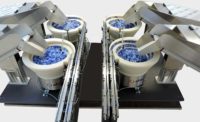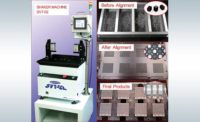Hearing loss is the third-most common chronic physical condition among adults after hypertension and arthritis.
Unfortunately, 24 percent of hearing difficulty among U.S. workers is caused by occupational exposures. Each year, about 22 million U.S. workers are exposed to hazardous noise levels at work. According to the National Institute for Occupational Safety and Health, the recommended limit for occupational noise exposure is 85 decibels, A-weighted, as an 8-hour time-weighted average. Exposures at or above this level are considered hazardous.
Earplugs, therefore, are an essential part of every worker’s personal protective equipment. Millions of them are produced annually on high-speed automated assembly systems.
Recently, a manufacturer of ear protection devices approached Fortville Feeders to design a system to feed two small parts—plastic stems for earplugs—to an automated assembly line at a high rate of speed. One end of the stem was wider than the other, and the stems had to be fed with the narrower end leading. In addition, damaged or irregular parts needed to be removed from the system automatically. This had been a problem with a previous feeding system, leading to defective assemblies and jams down the line.
Feeding these parts posed three major challenges. First, the parts were very small with few differences in geometry from one end of the part to the other. Nevertheless, it was critical that each part be oriented correctly. Second, they needed to be fed at a rate of 200 parts per minute to match the speed of the assembly equipment. Finally, the manufacturer wanted to run two different parts with the same feeding system, so the equipment had to accommodate quick changeovers.
Fortville Feeders engineers worked with the manufacturer to come up with a system that handles the parts as specified. Fortville built critical tooling that orients the parts and feeds them down two air-driven tracks. The speed of delivery requirement is met with two components: A fast-feed elevator keeps bulk parts flowing into the system. A sensor over the bowl triggers the elevator to supply more parts whenever the level of parts gets too low. An air-driven track moves the parts quickly through the system.
However, with such lightweight parts moving at a high speed, engineers were concerned that they would be blown and misaligned in the track. Fortville engineered a dual-line air track to contain the parts and move them to the next operation. The air pressure across the entire system is controlled by a series of pneumatic air regulators. Fortville had built numerous feeding systems that used the same technology for lightweight parts.
The system was designed to expedite changeover from one part to the other. A fully loaded bowl can be emptied and ready for new parts in less than 3 minutes. Each part has separate air pressure and flow settings, as well as different selectors and dedicated tracks. The mechanical components are all marked and are not adjustable. The pneumatic changeover is accomplished by a bank of regulators dedicated to each part setup. These use solenoid valves controlled by the manufacturer’s PLC, thus eliminating any adjustments from part to part.
The system was put through rigorous in-house testing. The manufacturer then sent a team of employees to Fortville to inspect the system, run it and perform a changeover before it was shipped out. In the end, the feeding system met all three challenges to the satisfaction of the manufacturer’s inspection team.
For more information on parts feeders, call Fortville Feeders at 317-485-5195 or visit www.fortvillefeeders.com.




